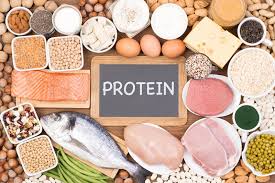
Protein is necessary for many things. Whether you want to lose weight, gain muscle, recover from a tough workout, feel more satiated at mealtime or simply maintain good health, it’s important to get adequate amounts of healthy protein. It gets digested into amino acids that are absorbed by the small intestine and distributed throughout the body. Getting enough protein is important so the body can perform these functions daily. But just like carbs and fat, excess protein gets converted into fat and stored as fat. Protein is found in a variety of foods: most notably meat, poultry, fish, dairy, eggs, legumes, nuts, seeds, soy and even grains.
HOW MUCH DO WE NEED?
The recommended dietary allowance (RDA) predicts how much protein you should eat on a daily basis to guard against lean muscle loss. The RDA for protein is 0.8 gram/kilogram of body weight, but this is a minimum for the average sedentary adult requirement. There are a few factors that determine your requirements, including:
1. Activity level (sedentary,
athlete, recreational athlete, etc.)
2. Weight
3. Goals (maintain muscle mass, build muscle mass, lose weight, etc.)
4. Age
Here’s how to Calculate the minimum amount of protein you should be eating:
- Your weight in kg multiplied to 0.8 equals to the amount in gm of protein necessary to maintain muscle mass
- For endurance activities (swimming, biking, running)- 0.9-1.1 g/kg
- For Strength training- 1-1.5gm per kg depending on the activity.
WHAT ARE THE SOURCES OF PROTEIN?




Do’s and Dont’s of Proteins-
PAIR PROTEIN WITH CARBS- This is especially important when you’re re-fueling after aerobic exercise (like running) since protein is needed for muscle repair and carbs are needed to restock energy stores.
Dos and don’ts of Protein-
SPREAD OUT PROTEIN BETWEEN MEALS- Protein-rich foods don’t come cheap, but you can maximize your body’s ability to digest, absorb and use protein by distributing it evenly throughout meals and snacks.
EAT PROTEIN IMMEDIATELY AFTER EXERCISE- Having a high-protein snack soon after exercise (ideally before the one-hour mark) is best because this is when muscles are sensitive to nutrients they can use to repair and grow.
SEEK OUT MORE PLANT PROTEIN- Vegetarian or not, we can all benefit from eating more plant-based protein. In addition to being great sources of protein, foods like beans, peas, quinoa and lentils are rich in other nutrients like fiber, vitamins and minerals.
CHOOSE LEAN MEAT- Opt for the leaner options, like 90/10 ground beef, which contains 90% lean meat and only 10% fat. If you’re a steak or burger-lover, limit red meat to once or twice per week since it’s high in saturated fat. Poultry is generally lean — but beware when buying ground chicken or turkey. Unless it says 100% ground turkey breast or chicken breast on the package, the meat has likely been ground up with the skin and fat, which means that turkey burger may not be any healthier than one made from ground beef. If you enjoy fish, aim to eat 3–4 ounces of it twice a week. Frozen or fresh, fish can be a great source of protein. Some — like salmon — are rich in omega-3’s, a healthy, unsaturated fat.
Special Considerations- Protein requirement for Children and Teens
For most adults, protein plays a role in performance, recovery and injury prevention. For children and teens, a healthy, balanced diet is important for the same reasons, as well as to provide for proper growth. Most children don’t prefer protein-rich foods, opting instead for carbohydrates in the form of cereal, chips, bread and pasta. It’s important that adults (parents and caregivers) provide a wide array of protein foods and encourage their inclusion at every meal and snack. Although protein bars and powders are popular with young athletes, children and teens should be encouraged to reach for real food, including yogurt, cheese, nuts, nut, turkey and soybeans.
Protein-rich Meals options-
Every meal should contain a protein, a healthy carb, vegetables and a healthy fat. Here are some of our favorite combinations that are easy to prepare and delicious!
- 2/3 cup cooked black beans served over 1/2 cup cooked quinoa and topped with salsa and guacamole
- 4 to 5 oz. wild Alaskan salmon, sautéed asparagus and wild rice, topped with slivered almonds
- 2 poached eggs served on top of 2 slices whole-grain bread and 1/2 smashed avocado
- 8 oz. plain Greek yogurt mixed with 1/2 cup berries, 1 Tbsp. each of chia, hemp and ground flax seeds
- 1 banana spread with 2 Tbsp. all-natural almond butter and topped with 1 Tbsp. chia seeds
- 4 turkey meatballs served over whole-grain pasta or spaghetti squash with marinara sauce and parmesan cheese .
For more guidance you can contact me for a personal consultation by fixing up an appointment on M-9820183412 or email me on dipti@happyhealthclub.com.
Happy to help always.


Leave a Reply